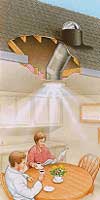
Vol. V, No. 1, January-March 2006
- How Long Does It Take to Complete an Early Education Center?
- One Size Does Not Fit All: Sizing Computers for Children
- Study Finds No Safe Level of Lead
- Lincoln Museum Receives Thea Award
- Let the Sun Shine In
- Evaluation of Full-Spectrum Fluorescent Lighting
- Valentine's Day in Morocco
- Plant a Private Space for Children
- Connecting the World's Children to Nature
- Upcoming Presentations
- Alert: Early Childhood Facilities Design Institute Is in Danger
- Current Projects
Let the Sun Shine In
 Over
the years, our enewsletter has extolled the benefits of daylighting for
young children. Studies by Kuller and Lindsten (1992) and the Heschong
Mahone Group (1999) demonstrate a positive correlation between day lighting
and academic performance. Daylighting gives off a continuous spectrum
of all light wavelengths, including blue, red and green, appearing as
a bright white. Daylight is the standard of color quality in lighting
with a color rendering (CRI) of 100. Natural light can lift our spirits,
make our classrooms seem larger and connect children with the outside
world. If you are thinking about building or renovating classrooms, one
way to achieve daylighting - another term for natural light - is to install
skylights, which come in the conventional or square design and in the
new tubular design. Both types provide interiors with natural lighting,
reduce the need for electricity and offer a host of other benefits. Tubular
skylights were developed in response to problems posed by the conventional
ones.
Over
the years, our enewsletter has extolled the benefits of daylighting for
young children. Studies by Kuller and Lindsten (1992) and the Heschong
Mahone Group (1999) demonstrate a positive correlation between day lighting
and academic performance. Daylighting gives off a continuous spectrum
of all light wavelengths, including blue, red and green, appearing as
a bright white. Daylight is the standard of color quality in lighting
with a color rendering (CRI) of 100. Natural light can lift our spirits,
make our classrooms seem larger and connect children with the outside
world. If you are thinking about building or renovating classrooms, one
way to achieve daylighting - another term for natural light - is to install
skylights, which come in the conventional or square design and in the
new tubular design. Both types provide interiors with natural lighting,
reduce the need for electricity and offer a host of other benefits. Tubular
skylights were developed in response to problems posed by the conventional
ones.
Conventional skylights are typically constructed of two panes of glass mounted to a wooden frame, while tubular skylights capture daylight through a small, durable plastic lens mounted on the roof. Light is directed down a reflective tubular shaft and can provide a high level of illumination even on cloudy days. In small classrooms, one tube light might provide uniform natural lighting, while in larger classrooms you would need several tubes to achieve the standard of 30 to 50 foot candles at children's work and play areas.
Advantages of sky tubes are that they are easier to install, permit less heat loss and tend to leak less than conventional skylights. Installation costs vary, but the costs may be able to be recouped in energy savings.
Vol. V, No. 1, January-March 2006
- How Long Does It Take to Complete an Early Education Center?
- One Size Does Not Fit All: Sizing Computers for Children
- Study Finds No Safe Level of Lead
- Lincoln Museum Receives Thea Award
- Let the Sun Shine In
- Evaluation of Full-Spectrum Fluorescent Lighting
- Valentine's Day in Morocco
- Plant a Private Space for Children
- Connecting the World's Children to Nature
- Upcoming Presentations
- Alert: Early Childhood Facilities Design Institute Is in Danger
- Current Projects

